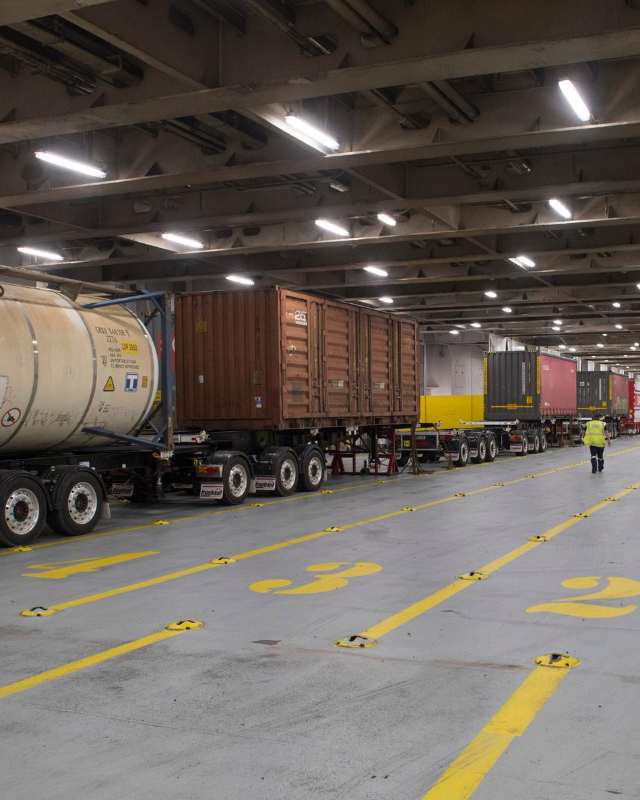Dangerous Goods
Dangerous goods declaration requirements
It is critical you ensure all loads comply with the IMDG code.
Please note: Required separation of 3M or 6M means separation from the entire unit, not within the unit.
- Complete an Interislander Dangerous Goods declaration via Passport. This is our preferred declaration method.
- For your Passport username and password, please email our team at freight@interislander.co.nz or call 0800 660 670.
- Alternatively, you may fill in an Interislander Dangerous Goods Declaration Manifest to suit your vehicle type - a combination vehicle (e.g. BTrain or Truck and Trailer) or a single vehicle (e.g. Semi or Truck) . The manifest contains all the necessary information required by the ship to identify compatibility of cargo and to complete stowage plans.
- View a sample copy of the manifest which shows how to complete the form.
- Submit your manifest to: tildangerousgoods@interislander.co.nz at least 4 hours prior to the scheduled departure of the vessel. Apart from supplementary paperwork for radioactive materials, this is the only document that needs to be sent to us. (Note, that manifests submitted via Passport do not need to be emailed).
Dangerous goods inspections:
All Commercial Vehicles carrying dangerous goods will be inspected at the terminal prior to being allocated a place on board, and once on board, a secondary check will be carried out by the loading deck mate. The checks will ensure:
- The vehicle has the correct paperwork and DG placards as per the IMDG Code; and
- The vehicle complies with the requirement of the New Zealand Transport Act 1994; and,
- No leaks are sighted or unusual smells emanating from the container/vehicle; and,
- Old DG placards are removed if these aren’t applicable to the freight being transported.
If a vehicle does not meet the requirements stated above, Interislander will refuse passage.
Checklist for correct completion of manifest
When completing the dangerous goods manifest, you must ensure the following fields are completed:
- UN Number and Proper Shipping Name
- Technical name if N.O.S.
- Packing Group (if required)
- Flash Point (for all items of Class 3 or with a subsidiary risk of Class 3)
- Weight and volume
- Number and type of packaging
- Stowage plan to indicate where your goods are stowed in the unit
- After hours contact name and number.
Passport will prompt you to complete the required fields.
In addition:
- Please ensure all other paperwork relating to the transport unit is available for inspection if required by terminal or ferry staff.
- Affix required placards to the front and rear of the transport unit.
- Please note: Interislander no longer stock placards on site at our terminals. Vehicles not displaying the correct placards will not sail until suitable placarding is obtained for travel.
Maritime codes and health and safety requirements
We are committed to the safety and wellbeing of all people involved in our operations – including employees, contractors, clients, partners and passengers. This also extends to the environment we interact with as part of our business.
Transporting dangerous goods across the Cook Strait is subject to the regulations of the Maritime Safety Authority. You are required to ensure your goods comply with the following regulations:
- IMDG Code.
- Maritime Rule Part 24A , 24B, 24C , 24D and 150
- SOLAS Chapter VII Carriage of Dangerous Cargo
- General Harbour Regulations 1968
- Maritime Transport Act 1994 Part 12:173 & Part 19
- Hazardous Substances and New Organisms Act 1996
Before accepting any cargo on board the vessel, our Masters and Officers who manage the cargo decks check that all cargo has the relevant certification and placarding to ensure it meets the IMDG code as required by Maritime New Zealand.
Health and safety is our priority and Interislander’s PCBU officers carry out their duties to ensure they have eliminated as many risks as far as is reasonably practicable as per the NZ HSE Act 2015.
Where it’s not reasonably practicable to eliminate health and safety risks, our officers will look to minimise the risks. Interislander requires all commercial vehicle customers to ensure 100% compliance to the regulations stated above before arriving at our terminals.
Training is mandatory for all those involved in the transport chain of dangerous goods by sea. This applies to consignors, shippers and forwarders, container packers and consolidators, shipping line operations and booking staff, stevedores and port staff. Details and guidance on the requirements are in the IMDG chapter 1.3.
For more information visit www.imdge-learning.com
Stowage categories
Category A dangerous goods are permitted to be carried on passenger sailings, with the exclusion of radioactive material which is limited to Aratere sailings only.
Category D & E dangerous goods are limited to our freight only sailings. For any enquiries, please call 0800 660 670.
Safety requirements for CV drivers
We operate machinery and plant at our terminals and onboard our ferries that has the potential to cause notifiable injuries and illnesses.
To help you stay safe, please read the Interislander CV Safety Briefing and familiarise yourself with the hazards and the appropriate controls at our terminals and on board the ferries.
Please be on the lookout for the Personal Protective Equipment Zones in the commercial vehicles area of the Picton and Wellington terminals. Hi Vis clothing to AS/NZS4602 standards and safety footwear is mandatory in these zones.
